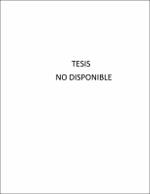Efecto de la sustitución de harina de trigo (Triticum aestivum) por harina de plátano (Musa acuminata) variedad ingiri sobre el color, volumen especifico, textura, fibra cruda y aceptabilidad general en el pan de molde integral

Ver/
Descargar
(application/pdf: 80.79Kb)
(application/pdf: 80.79Kb)
Fecha
2017Autor(es)
Alvitres Reyes, Barbara Carolina
Metadatos
Mostrar el registro completo del ítemResumen
El objetivo de esta investigación fue evaluar el efecto de la sustitución de
harina de trigo (Triticum aestivum) (5, 10 y 15%) por harina de plátano (Musa
acuminata), variedad Ingiri, sobre el color, volumen específico, textura, fibra
cruda y aceptabilidad general en pan de molde integral.
Las variables fueron evaluadas a las 24 h de haberse elaborado el pan de
molde integral. El análisis estadístico de las variables paramétricas se realizó
con la prueba de Levene modificada, para determinar la homogeneización de
las varianzas; el análisis de varianza, para las diferencias significativas; y la
prueba de Duncan, para el mejor tratamiento, que correspondió al 5% de
sustitución de la harina de trigo por harina de plátano. Todas las prueba
estadísticas se realizaron al nivel de confianza del 95%. El pan elaborado con
5% de sustitución de harina de trigo tuvo los mejores valores de L* (64.87), a*
(1.59) y b* (15.78); el mayor volumen específico (0.0036 m 3 /kg) y la mejor
textura (1.32 N); en tanto que, el pan elaborado con 15% de susti tución de
harina de trigo tuvo el mayor contenido d fibra cruda (2.46%).
El análisis estadístico de los valores de la aceptabilidad general fue realizado
con la prueba de Friedman y Wilcoxon, con lo que se demostró que el pan
elaborado con 5% de sustitución de harina de trigo por harina de plátano tuvo
la mayor aceptabilidad general, con una moda de 8, en la escala hedónica de
nueve puntos, equivalente a “Me gusta mucho.
“ The aim of this research was to evaluate the effect of replacing integral wheat
(Triticum aestivum) flour (5, 10, and 15%) by plantain (Musa acuminate) flour,
Ingiri variety, on the color, specific volume, texture, crude fiber, and general
acceptability in integral mold bread.
Variables were evaluated at 24 h after having elaborated integral mold bread.
Values of parametric variables were statistically evaluated by modified Levene
test, to determine variance homogenization; analysis of variance, for significant
differences; and Duncan test, for the best treatment, the same as was with 5%
of substitution of integral wheat flour by plantain flour. All statistical tests were
carried out at 95% of confidence level. Bread made with 5% of substitution of
wheat flour had de best values of L* (64.87), a* (1.59), and b* (15.78); the
highest specific volume (0.0036 m 3 /kg); and the best texture (1.32 N); in so far
as, the bread made with 15% of substitution of wheat flour had the highest
content of crude fiber (2.46%).
Statistical analysis of general acceptability values was carried out with Fiedman
and Wilcoxon tests, to show that the bread made with 5% of substitution of
wheat four had the highest acceptability, with a mode of 8, in the hedonic scale
with 9 points, equivalent to “I like it much”.
Palabras clave
Colecciones
- Industrias Alimentarias [152]

